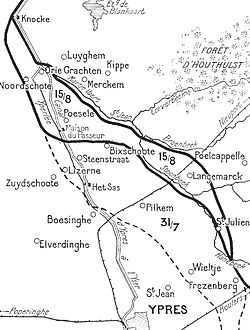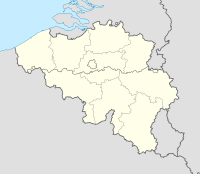| Action of 22 August 1917 | |||||||
|---|---|---|---|---|---|---|---|
| Part of the Third Battle of Ypres of the First World War | |||||||
 Front line after Battle of Langemarck, 16–18 August 1917 | |||||||
| |||||||
| Belligerents | |||||||
|
|
| ||||||
| Commanders and leaders | |||||||
|
Sir Douglas Haig Hubert Gough |
Crown Prince Rupprecht Sixt von Armin | ||||||
| Units involved | |||||||
|
14th (Light) Division 15th (Scottish) Division 61st (2nd South Midland) Division 18th (Eastern) Division 11th (Northern) Division Tank Corps | Gruppe Ypern | ||||||
| Strength | |||||||
| 6 brigades, 18 tanks | |||||||
| Casualties and losses | |||||||
| 4,508 (excl. XVIII Corps) | |||||||
St Julien, in West Flanders | |||||||
The action of 22 August 1917, took place during the First World War, in the Ypres Salient on the Western Front as part of the Third Battle of Ypres. The engagement was fought by the Fifth Army (General Hubert Gough) of the British Expeditionary Force and the German 4th Army (Lieutenant-General Sixt von Armin). During the Battle of Langemarck (16–18 August), the British had advanced north of the village but had been defeated further south and failed to capture the Wilhelmstellung, the third German defensive position. At a conference with the Fifth Army corps commanders on 17 August, Gough arranged for local attacks to gain jumping-off positions for another general attack on 25 August. At the action of the Cockcroft on 19 August, XVIII Corps and the 1st Tank Brigade had captured five fortified farms and strongpoints for a fraction of the casualties of a conventional attack.
The attack on 22 August was much bigger effort, which advanced the British front line up to 600 yd (550 m) in places, on a 2 mi (3.2 km) front but failed to reach the more distant objectives. On 24 August, a German Gegenangriff (methodical counter-attack) recaptured Inverness Copse on the Gheluvelt Plateau and the more ambitious British attack due on 25 August was cancelled. It began to rain again on 23 August and torrential rain fell on 26 August, flooding the battlefield. Haig transferred responsibility for the offensive to General Herbert Plumer and the Second Army, to include the southern edge of the Gheluvelt Plateau in the offensive. As reinforcements were transferred from the armies further south, the Fifth Army continued with minor operations. On 27 August, the Springfield and Vancouver blockhouses were captured by tanks supported by infantry from the 48th (South Midland) Division but most attacks were costly failures. The quantity of casualties and the cold, wet and muddy conditions lowered morale among the infantry on both sides.
© MMXXIII Rich X Search. We shall prevail. All rights reserved. Rich X Search

